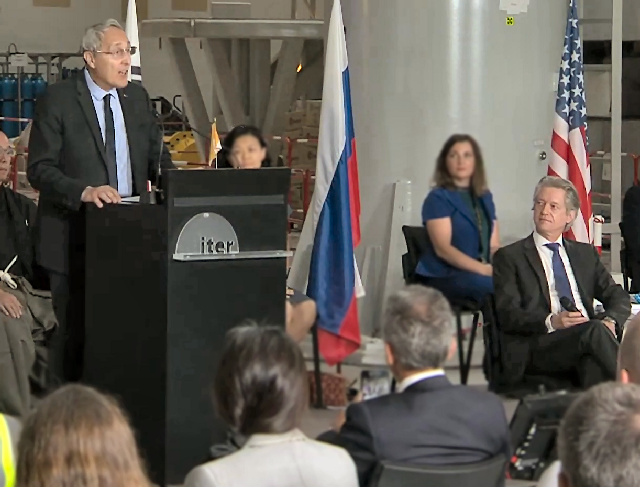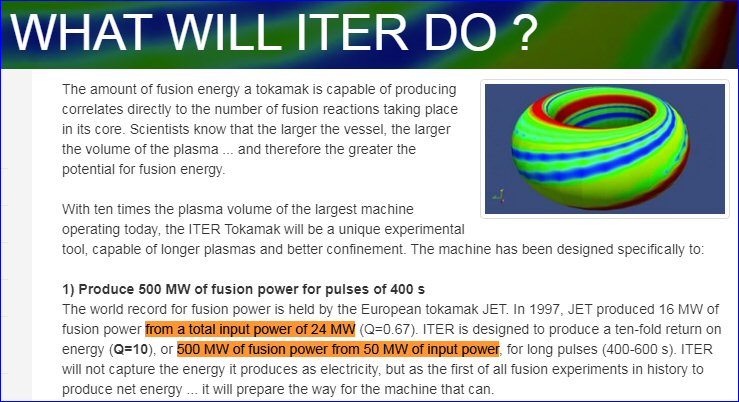First experiments probably in 2031
Back to the ITER Power Facts main page
By Steven B. Krivit
Oct 26, 2021
In ten years the ITER schedule has fallen ten years behind schedule.
Bernard Bigot, the general director of the ITER organization, will officially notify his governing body, the ITER Council, of another construction delay at its November meeting, according to several sources speaking with the New Energy Times.
But the ITER project’s schedule is further back than the organization will publicly announce – even to the ITER Council, an ITER organization official told the New Energy Times. The employee requested anonymity as he was not allowed to speak on behalf of the organization.
When the construction of the International Thermonuclear Experimental Reactor ITER is completed, experiments with test fuels – hydrogen and deuterium – are to begin. This milestone is known as the “first plasma”. These test experiments are slated to take seven years before scientists are confident enough to add radioactive tritium to the fuel mixture.
After two years of experimentation with deuterium-tritium fuel, the team hopes to increase the input power and get the maximum power gain from the reactor.
According to the source, in internal documents of the ITER organization, three possible dates appear for the first plasma along with the following comments:
2027: Not realistic, not achievable
2029: Realistic, Optimistic
2031: Realistic, achievable
New Energy Times is therefore adjusting our planned schedule again (according to ITER employees, not management).
Estimated ITER First Plasma Date
Evasive answer
In 2006 the first plasma was planned for 2016. In 2012 it was postponed to 2020. In 2014, Nature reporter Elizabeth Gibney spoke to the previous General Director Osamu Motojima about the schedule. Gibney had heard rumors that people were talking openly about 2022 or 2023.
She asked Motojima for a new, realistic date for the first plasma. He gave an evasive answer. She asked again and gave the dates for 2022 and 2023.
“There are a lot of rumors,” said Motojima. “I have the target date, but I have to show that there is a sufficiently high probability that we can make it. It will be around 2022 or 2023 and I will report to the ITER Council next June. If the date is 2025, the project will never survive. “
The project survived, but Motojima’s appointment did not. On March 5, 2015, the ITER Council replaced him with Bigot. When Bigot spoke to Agence France-Presse two months later, he told the news agency that every year delay increases the cost by 200 million euros.

Bernard Bigot (on the podium) and Laban Coblentz (seated) during the media event 2020
Date deviation
Later in 2015, science reporter Daniel Clery learned that the official data for the first plasma was “widely recognized as 2025” by all but the ITER administration. Clery wrote that the official schedule had been “largely discredited” by then.
Claims of false power
However, like everyone else, Clery was misled by ITER management and its merger advocates that the ITER reactor was designed to “generate 500 megawatts of electricity from 50 megawatts of power”. If so, the ITER reactor would be well on the way to delivering a ten-fold increase in performance.
In fact, the 50 MW value only applies to the heating power fed in and used to heat the fuel. In reality, the reactor needs at least 500 megawatts to start up, and between 300 and 400 megawatts in continuous operation. (See New Energy Times ITER Power Research and Analysis here.)
The scientific goal of the project has nothing to do with the efficiency gain of the reactor. The gain applies only to the power gain of the physical reactions. So if the ITER reactor achieves its scientific goal, it will produce zero reactor net power and show zero reactor power gain.
But merger advocates have rarely disclosed this distinction when speaking to the public – or their own representatives. In 2008, when the management of the ITER organization told Neil Calder, the organization’s first spokesman, to tell journalists that the reactor only needed 50 MW of power to generate 500 MW, the ITER management misinformed him.

False and misleading 2008 statement by Neil Calder, former head of public communications for ITER (source)
“Everyone said that, that was the point of ITER,” Calder told the New Energy Times. “At that time I spoke to everyone on the management board, and as far as I can remember, there were no disagreements down the line.”
When the ITER organization claimed for years on its website that the reactor was “designed to generate 500 MW output power from 50 MW input power” – without explaining that the 50 MW value only applies to the fed-in heating power, without explaining that the 50 MW figure didn’t include most of the input power the reactor will need – its management misinformed everyone.

False claims made by the ITER organization as published on their website on October 5, 2017 (Click here to see the ITER organization’s correction just after October 5, 2017)
When the ITER organization claimed in a press release from 2017 that the zero net power reactor should “prove that fusion energy can be produced on a commercial scale”, its management again misinformed everyone.
When the ITER organization claimed in a 2020 press release that if the zero net power reactor were connected to the grid, its thermal output of 500 megawatts would mean “about 200 megawatts of electrical output,” their management re-informed everyone not correct.
Proponents of ITER and Fusion have misinformed everyone for decades: they use the same formula to amalgamate fusion reaction power values with fusion reactor power values, underestimate the power ITER will need to produce 500 MW of thermal power, and don’t openly state that With an input value of 50 MW, most of the power required for ITER is lost. They used the same formulaic misrepresentation when reporting the outcome of the JET reactor to everyone, claiming that the reactor produced 16 MW of thermal power “from a total input of 24 MW” instead of 700 MW.

False claims made by the ITER organization as published on their website before October 6, 2017 (Click here to see the ITER organization’s correction just after October 5, 2017)
The primary measurable goal of the ITER reactor has nothing to do with proving that fusion energy can be produced on a commercial scale, contrary to the claims made by Laban Coblentz, the current ITER spokesman, in the 2017 press release theoretical rate of electricity production that the reactor could produce, contrary to what Coblentz said in the 2020 press release.
Coblentz knew that five years ago. He told the New Energy Times on Dec. 22, 2016 that the primary measurable goal of the reactor is to “generate approximately ten times more power from the plasma than it enters the plasma,” rather than increasing the power of the entire reactor.
The film
ITER is an experimental zero power fusion reactor concept that is dishonestly advertised as a 500 megawatt reactor. This documentary from April 2021 tells the story:



Comments are closed.